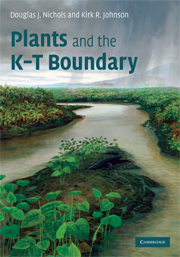Book contents
- Frontmatter
- Contents
- Preface
- PART I BACKGROUND
- 1 Introduction
- 2 Resolution of the K–T boundary
- 3 Using fossil plants to study the K–T boundary
- 4 Brief history of K–T boundary paleobotany and palynology
- 5 Overview of latest Cretaceous and early Paleocene vegetation
- PART II REGIONAL CASE STUDIES
- PART III INTERPRETATIONS
- Appendix
- References
- Index
5 - Overview of latest Cretaceous and early Paleocene vegetation
Published online by Cambridge University Press: 22 August 2009
- Frontmatter
- Contents
- Preface
- PART I BACKGROUND
- 1 Introduction
- 2 Resolution of the K–T boundary
- 3 Using fossil plants to study the K–T boundary
- 4 Brief history of K–T boundary paleobotany and palynology
- 5 Overview of latest Cretaceous and early Paleocene vegetation
- PART II REGIONAL CASE STUDIES
- PART III INTERPRETATIONS
- Appendix
- References
- Index
Summary
Late Cretaceous vegetation
Paleobotanists divide Phanerozoic time into three eras: the Paleophytic, Mesophytic, and Cenophytic (Traverse 1988b). The Mesophytic–Cenophytic boundary lies nowhere near the Mesozoic–Cenozoic boundary. Because it is defined by the first appearance of the angiosperms, the Cenophytic begins in the earliest stages of the Cretaceous, some 60–70 million years before the K–T boundary. Angiosperm evolution was rapid in the Cretaceous and global summaries based on megafloral and palynofloral data (Crane and Lidgard 1989, Lidgard and Crane 1990, Drinnan and Crane 1990) show an equatorial origin in the Barremian followed by an explosive race to polar latitudes by the Cenomanian. Nearly all Cenomanian and post-Cenomanian megafloras are dominated by angiosperms. In terms of temperature, Wolfe and Upchurch (1987b) using leaf margin analysis documented a gentle warming from the Albian to the Santonian, followed by a gradual cooling to the early Maastrichtian, culminating with a rapid late Maastrichtian warming. Huber et al. (1995) used isotopic analysis of marine foraminifera to generate a Late Cretaceous temperature curve with similar trends but with no obvious latest Maastrichtian warming. Subsequent more detailed analysis of magnetostratigraphically calibrated marine and terrestrial records shows warming occurred within the last 500 000 years of the Cretaceous both in deep-sea cores and in terrestrial deposits (Wilf et al. 2003).
The latest pre-angiosperm Mesophytic Era (Early Cretaceous, Berriasian–Barremian) is characterized by the Wealden flora of southern England (and correlative floras in France, Belgium, Germany, Spain, and Portugal).
- Type
- Chapter
- Information
- Plants and the K-T Boundary , pp. 46 - 66Publisher: Cambridge University PressPrint publication year: 2008



